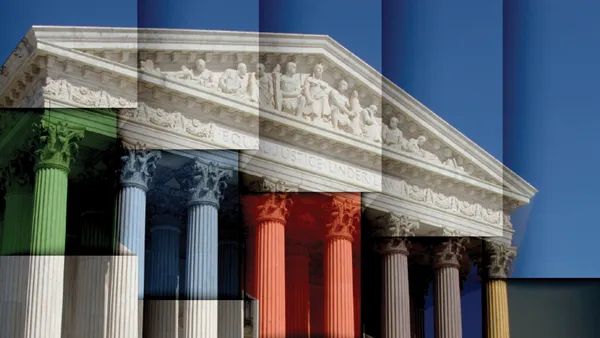As the supreme law of the land, the U.S. Constitution creates a federal system of government in which power is shared between the federal government and the state governments. Both the federal government and each of the state governments have their own court systems. Discover the differences in structure, judicial selection, and cases heard in both systems.
As the supreme law of the land, the U.S. Constitution creates a federal system of government in which power is shared between the federal government and the state governments. Both the federal government and each of the state governments have their own court systems. Discover the differences in structure, judicial selection, and cases heard in both systems.
Court Structure
| The Federal Court System | The State Court System |
|
Article III of the Constitution invests the judicial power of the United States in the federal court system. Article III, Section 1 specifically creates the U.S. Supreme Court and gives Congress the authority to create the lower federal courts. |
The Constitution and laws of each state establish the state courts. A court of last resort, often known as a Supreme Court, is usually the highest court. Some states also have an intermediate Court of Appeals. Below these appeals courts are the state trial courts. Some are referred to as Circuit or District Courts. |
|
Congress has used this power to establish the 13 U.S. Courts of Appeals, the 94 U.S. District Courts, the U.S. Court of Claims, and the U.S. Court of International Trade. U.S. Bankruptcy Courts handle bankruptcy cases. Magistrate Judges handle some District Court matters. |
States also usually have courts that handle specific legal matters, e.g., probate court (wills and estates); juvenile court; family court; etc. |
|
Parties dissatisfied with a decision of a U.S. District Court, the U.S. Court of Claims, and/or the U.S. Court of International Trade may appeal to a U.S. Court of Appeals. |
Parties dissatisfied with the decision of the trial court may take their case to the intermediate Court of Appeals. |
|
A party may ask the U.S. Supreme Court to review a decision of the U.S. Court of Appeals, but the Supreme Court usually is under no obligation to do so. The U.S. Supreme Court is the final arbiter of federal constitutional questions. |
Parties have the option to ask the highest state court to hear the case. |
|
Only certain cases are eligible for review by the U.S. Supreme Court. |
Selection of Judges
| The Federal Court System | The State Court System |
|
The Constitution states that federal judges are to be nominated by the President and confirmed by the Senate. They hold office during good behavior, typically, for life. Through Congressional impeachment proceedings, federal judges may be removed from office for misbehavior. |
State court judges are selected in a variety of ways, including
|
Types of Cases Heard
| The Federal Court System | The State Court System |
|
State courts are the final arbiters of state laws and constitutions. Their interpretation of federal law or the U.S. Constitution may be appealed to the U.S. Supreme Court. The Supreme Court may choose to hear or not to hear such cases. |
Understanding the Federal Courts
Want to further develop your knowledge of the federal courts? Read Understanding the Federal Courts.
Court Shorts: Rule of Law
What does the rule of law mean, and how does it affect our daily lives? Nine federal judges explain how fair and consistent adherence to the law protects our rights and well-being in everyday situations like buying a breakfast sandwich, reading mail, and investing in the stock market.

